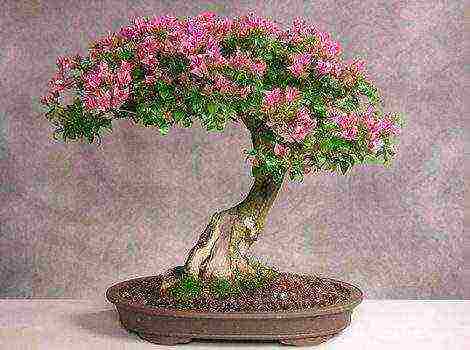Content [show]
Refined and bright, this miniature decorative rose will adorn any interior. It belongs to the Rosaceae family and in the indoor version is a small neat bush from 35 to 45 cm. Proper care will give excellent flowering from spring to autumn. Today there are several hundred varieties of indoor roses. Some varieties exude a delicate aroma, while others are completely odorless.
This plant is of a temperate climate, so it does not require special conditions for breeding. Caring for her is not very difficult, but during the flowering period she will require attention. And, of course, he will thank you with luxurious flowers.
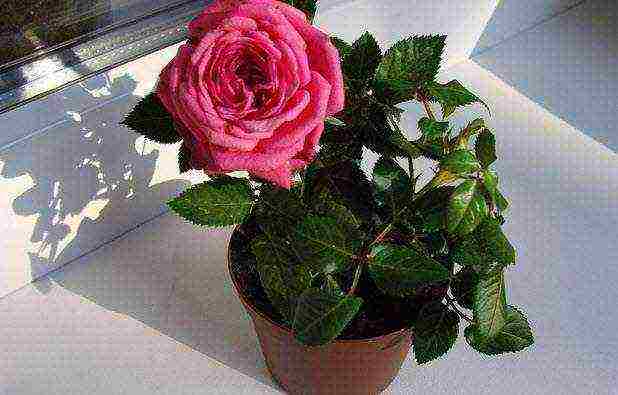
Features of growing a home rose
Indoor rose blooms in spring and summer, at this time it needs light and good watering. For abundant flowering, she definitely needs a dormant period, which is best organized in winter.
This houseplant tolerates low temperatures well, but is demanding on air and soil moisture. She is very light-requiring, but direct sunlight can harm her. Rose loves to "swim", so you should follow the regime of water procedures. She needs fresh air all year round.
Important! After the purchase, do not rush to transplant it. It is better to do this in two weeks, then it will better adapt to new conditions.
Planting a room rose
Planting a room rose is not troublesome. It is important to know that the root system of the plant is very delicate, so it is better to transplant it by transshipment. Before planting a rose, you need to prepare a pot. A new pot needs to be soaked - pour water and leave for a day. The pot from under the old plant must be thoroughly cleaned with a brush without the use of detergents.If there is a drainage hole in the pot, then the expanded clay layer can be no more than 1 cm, if not, then 3 cm.
Planting methods
Planting a room rose by cuttings.
Optimal planting time
The best time to plant a room rose is from May to September.
Plant soil (Soil composition)
A potted rose requires a nutritious, breathable soil. It is best to use ready-made primer by purchasing it in a store. The optimal composition of the soil for a plant is sod and humus of the earth, sand in proportions of 4: 4: 1, respectively. Loosening the soil is not recommended because of the danger of damaging the roots. Rose prefers neutral soil.
Features of caring for a room rose at home
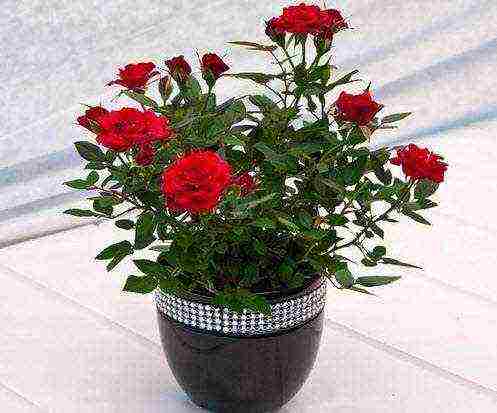
There are some features in the care that are characteristic of this particular indoor plant.
Location and lighting for the plant
The rose needs fresh air, so the ideal placement for her is a balcony or a garden bed in summer (you can take her with you to your country house if you spend there all summer). However, it is not recommended to leave it unattended, because it requires frequent watering in summer during the flowering period.
At home, the rose is best placed on the southeast or south side, because it loves a lot of light. In the fall, when the daylight hours are short, she needs to turn on additional lighting from a fluorescent lamp. This is done to extend the flowering period.
In winter, during the rest period, a comfortable temperature for a rose is +10 - +12 degrees. If there is an opportunity to put it on a glazed loggia or balcony, it will have a good rest. Indoor winter temperatures are not very suitable for her. If it is not possible to keep the flower at a low temperature, you should protect it as much as possible from the heat of the batteries and dry air.
It is advisable to turn a pot with a miniature room rose from time to time to the light in different directions.
Important! If the rose hibernates on a glazed loggia, in order to avoid freezing of the soil, the pot with the plant can be put in a box and sawdust sprinkled around it.
Air humidity
Indoor mini roses need high humidity. When they are outside (on the balcony or in the garden), additional moisture is not required. In winter, if the rose is in the room, it is better to keep the pot with it in a tray with damp pebbles.
The rose needs weekly water sprays. If the room is cool in winter, it is better not to spray the rose. If the air is too dry and warm, spraying should be carried out 1-2 times a week, even in winter.
Never spray the rose during the day in hot summer weather.
Important! In a dry atmosphere, pests can appear on the flower.
Temperature regime for a flower
The most comfortable temperature for a rose in the summer is +14 - +25 degrees. In winter, the rose needs coolness - no higher than +15 degrees.
How to water properly
Indoor rose does not tolerate both drying out and excessive watering. In the summer, when the rose blooms, watering is necessary 2 times a day - in the morning and in the evening. Watering is necessary with settled water at room temperature.
In autumn, when the rose sheds its leaves, watering should be reduced to 1 time per week if the rose hibernates on the balcony. If it is in a room at a fairly high temperature, it should be watered as the topsoil dries out.
You can alternate top and bottom watering (watering the soil and filling the pan). In any case, excess water from the pallet must be drained to avoid root rot.
In the spring, as the plant awakens, watering should be gradually increased.
Fertilizing and fertilizing a rose flower
Due to the long flowering, the rose loses strength and needs fertilization of the soil. They begin to feed her towards the end of February 1 time in 10 days. It is recommended to alternate mineral fertilizers with organic ones.
If you just transplanted a flower into fresh soil, you do not need to fertilize it.
Important! Before fertilizing, the flower must be watered with warm water.
How to prune a room rose?

Pruning the mini rose is necessary in order to stimulate the ovary. During the flowering period, it is imperative to cut the wilted flowers as short as possible.
The flower is routinely pruned in the fall in preparation for the dormant period. You can also do this in the spring.
Pruning methods
Pruning must be done with a sharp tool so that no torn parts remain on the branch, this can lead to the death of the entire plant. Trim the branches to healthy tissue, above the bud, which is facing outward. An oblique cut is made about five millimeters above the kidney.
It is necessary to remove all weak or dry shoots, as well as those that do not have an upper bud. When two shoots are intertwined, one of them is removed. If, after pruning, two stems appear from one bud, the extra ones must be cut off.
Important! Spring pruning should not be carried out until at least 10-hour daylight hours, otherwise young shoots will not be able to fully develop.
Home rose transplant
A transplant is necessary for a rose in two cases - after purchase and as the plant grows.
Transplant methods
After the purchase
Before replanting a rose after purchase, it needs to be allowed to adapt. No need to touch it for two weeks. First, the flower itself is prepared. A pot with a rose is placed in water, so it needs to stand for about half an hour. Then the rose needs to be bathed with a contrast shower (hot water no higher than 40 degrees). After bathing, a greenhouse is made from a plastic bag so that it does not touch the leaves (the edges of the bag can be pinned to the ground). The greenhouse needs to be aired daily. The rose will be ready to transplant when the flowers begin to wilt. They need to be removed and the plant can be replanted.
Immediately before planting, the flower must be removed from the pot and its roots immersed in warm water to wash off the remnants of the chemicals that the rose was fed with in the greenhouse. Soak a ceramic pot in water for a day.
A drain is placed at the bottom of the pot, then a layer of soil. The plant is placed in a pot and covered with earth so that it is tamped tightly. The size of the pot should be slightly wider and taller than the previous container.
As needed
Rosa really does not like unnecessary anxiety, so an annual transplant is not required, unless the pot becomes too small for her. New dishes for roses are prepared in the same way - they are cleaned and soaked. A pot with a rose is placed in a container of water for 30 minutes so that the earthen lump is easier to separate from the pot. Then the flower is simply transferred into a new pot and fresh substrate is poured, tamping it around the flower.
After transplanting, you do not need to water the flower, but it is better to put it in a shady place. Later, you can move it to a permanent, well-lit place.
Important! Start feeding no earlier than a month after transplanting.
Reproduction of a room rose. Breeding method

You can propagate a room rose by cuttings. The stalk is cut with a sharp knife, its length should be no more than 10 cm. It is better to treat the tool with a solution of potassium permanganate or alcohol. The cut should be oblique, right under the kidney, so the cutting will take root better. The upper cut is made 5 mm above the kidney. It is better to remove the leaves from the lower part of the cutting. There are two options for cutting a room rose:
Soil
Cuttings can be placed in water for a short time with the addition of heteroauxin (14 tablets per glass of water). After 10 hours, the cuttings are planted in a mixture of sand and peat, or simply in the sand. Then they create greenhouse conditions using film or a cut water bottle. It is not necessary to water a lot so that the cuttings do not start to rot. The temperature should be at least +18 degrees; direct sunlight should be excluded.
The cuttings will take root after about a month, after which they can be opened to adapt to the drier air, and then transplanted into separate containers.
Water
Cuttings need to be cooked as well, only their length should be about 15 cm.Then they are placed in a jar or glass of water, covered with a cardboard lid with holes into which the cuttings are inserted. The lower part should be immersed in water by 1.5-2 cm. If the humidity is too low, the cuttings should be sprayed. They can be transplanted into pots when the roots grow 1-1.5 cm and begin to branch well.
Important! For good rooting and development of cuttings, they need at least 15 hours of daylight.
Blooming room rose

Subject to all the rules for caring for a room rose, it will bloom from late spring to autumn. If dead buds are removed in a timely manner, the rose will bloom continuously during this period. To prevent the pots from overheating in the sun, they can be wrapped in white paper.
When the plant is in bloom (flowering period), the flower shape
In the spring, the rose begins an active growing season, and then it blooms. Flowers can be of a variety of colors - from amazing tea to maroon. The flowers are much smaller than the garden rose we are used to.
Plant care after flowering
At the end of flowering, the rose needs pruning and preparation for rest. If the roses were in the fresh air, they should be brought into the room as soon as the temperature drops below +12 degrees. After pruning, you should gradually reduce watering and stop feeding.
Problems, diseases and pests in the flower
Problems with a room rose can arise due to improper care. The reason for the lack of flowering can be:
- Eating disorder
- Increased acidity of the soil
- Lack of lighting
- Incorrect transplant
- Drafts
Of the diseases, the rose can be affected by chlorosis, which is treated with iron chelate. The yellowing of the plant indicates its defeat by the fungus. In this case, you need to treat the rose with a fungicide.
The same must be done with powdery mildew (white bloom on the rose).
Of the pests, the indoor rose is most often affected by the spider mite (a thin web appears between the leaves). A spider mite on a room rose can lead to viral diseases. You need to treat the flower with Apollo or Fitoverm preparations.
Thrips or aphids on indoor roses are no less a threat. They infect buds and leaves, deforming them. It is treated with insecticidal preparations for indoor plants.
Common types
Bengal rose
This is perhaps the most common variety of indoor roses. The Bengal rose is absolutely unpretentious, it differs in that it does not shed its leaves after flowering. Flowers are odorless. Does not require pruning, except for dried or diseased branches.
Miniature rose
The bushes are no higher than 30 cm, the flowers are collected in inflorescences and have a delicate aroma. Flowers can be white to black. Differs in abundant flowering and does not need pruning.
Baby Carnival
It is characterized by abundant flowering, perfect for both rooms and for decorating garden borders. This yellow indoor rose is always loved by flower growers.
Pixie
This variety is distinguished by two-colored double flowers - white with a pink center. It blooms profusely and for a long time, reaches a height of only 20 cm.
Eleanor
More common in the south. Bushes 30 cm tall are covered with coral flowers. The flowers themselves are collected in inflorescences of 10-15 pieces.
As a reference, do not confuse miniature indoor roses with Chinese indoor roses. The latter has nothing to do with roses and is called hibiscus.
Useful tips (Note to the flower grower)
A few more useful tips for caring for a beautiful rose:
- Remember, a rose will be bad both in a pot that is too close and in a very spacious pot. When transplanting, take a container slightly larger than the previous one, and when planting consistently increase the size of the pot
- When planting and transplanting, you can add special granules to the substrate that will prevent the roots from rotting and rotting.
- The smaller the pot, the more often the rose should be watered (the soil dries out faster in a small pot).
Answers to readers' questions

Plant lifespan
This plant is perennial and can live for a long time with good care.
Is this flower poisonous?
Indoor rose is not a poisonous plant.
Why doesn't the rose bloom?
In the previous chapters, situations were described when a rose stops blooming or does not bloom at all. This may be due to a violation of the maintenance of the plant, as well as exposure to pests. The flower must be examined. If no pests are observed, you need to change some care parameters and observe the plant.
Why does the indoor rose dry (wither)?
If the plant withers and the buds fall off, it means that it lacks watering. If this continues with normal watering, look for signs of disease or pests.
How does the plant overwinter?
The best wintering for a room rose will be a balcony with a temperature not higher than +15 degrees. This is a dormant period for the plant, so watering is minimal and top dressing is needed.
Who can resist the charm of delicate rosebuds? Certainly not keen growers!
Therefore, every flower lover must have a rose in a pot in his home collection.
Very often the purchase of a rose is spontaneous. Indeed, they look very attractive in the store. Indoor roses are often given to women who love flowers.

In any case, if you purchased a rose or received it as a gift, our article will definitely come in handy.
How to keep a room rose after purchase
Rose is not an easy flower for home keeping, it is quite demanding and capricious. It is not enough to become the happy owner of this beauty, it is also necessary to preserve the flower and find an approach to it, otherwise the sad consequences will not be long in coming.
Yes exactly. The purchased plant usually looks fresh and full of energy, blooms amazingly and it seems that it will always be so.

In fact, the plants end up on the counter fed with all kinds of stimulants, in addition, they have a special package that retains high humidity. Getting on our windowsill, roses are deprived of all this.
Almost immediately, inexperienced flower growers have problems: roses begin to turn yellow, their leaves dry and fly around, the buds fall off and turn black. The rosette orders to live long and disappears, leaving behind nothing but frustration.
It should be noted that the rose is considered an open field plant. Some varieties are more adapted for living in an apartment than others. But this does not mean that keeping them in an apartment is an easy matter.
When purchasing a room rose, after the purchase, you just need to take a set of rescue measures, even if the plant looks healthy and strong. Believe me, it won't be long!
So what are the steps to take when you brought the rose home:
- Remove the packing wrap, if present. Although the packaging helps to maintain moisture, but because of it, the rose is often affected by fungal diseases while still in the store. packaging interferes with air exchange, creating an ideal environment for fungi.
- Use pruning shears or scissors to remove any withered leaves, blackened or dried stems on the plant.
- Flowers and buds also need to be cut. Of course, for the sake of them we acquire a plant and would like to admire them enough, but the plant, the flowering of which was stimulated by special preparations and greenhouse care, subsequently simply cannot withstand such abundant flowering, and having given all its strength to it, dies. Therefore, we cut off all flowers and buds that are present on the plant, along with the bearing stem.
- Pay attention to the number of bushes in the pot. Indoor rose growers often plant multiple plants in one pot to create the appearance of a lush flowering bush. Crowded plants weaken each other, nutrients are lacking. Bushes, if there are several of them, must be planted in different pots.
- After the transplant, it is necessary to treat the rose with antifungal drugs (Fitosporin) and pest drugs (Fitoverm).
Transplanting a room rose
To transplant a rose, remove it from the previous pot along with an earthen lump. Assess the condition of the roots surrounding the earth.
If the roots are thin, like hair, brown or blackened, dry or rotten, then the plant will most likely die. You can try to save him: cut the cuttings and try to root them.
Healthy roots are bright white or yellowish in color and look quite dense, like a thin wire. If the roots have disappeared only partially, you need to remove all rotten and damaged ones, leaving healthy ones.
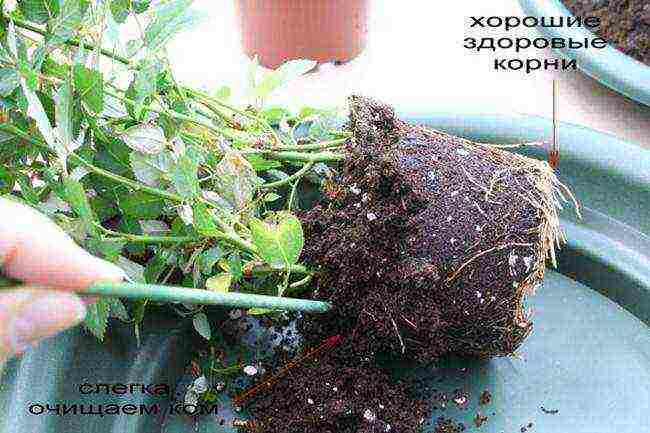
Pour expanded clay or other drainage at the bottom of the new pot.
It is better to buy a soil mixture ready for roses or garden. Do not take cheap soil, it contains a lot of peat and few useful substances. Better to choose a better quality potting mix.
You can make a soil mixture yourself, taking: 1 part of humus + 1 part of leafy land + 1 part of coniferous land + 3 parts of sod land + 1 part of sand.
Cover the drainage with earth, compact a little. Place the rose bush together with an earthen lump, cover with new earth, periodically compacting it so that the bush does not hang out in the pot, but is well fixed. Pour with settled or filtered water at room temperature.
Treatment for diseases and pests is necessary. A pruned and transplanted plant is weakened and susceptible to disease, even if it has been well cared for in the store and has not been contaminated. Therefore, it is better to play it safe and process it.

Also, after transplanting, treatment with Epin is effective - it will strengthen the plant's immunity and reduce the stress from transplanting.
Spray your plant, it needs high humidity, especially in conditions of working heating and dry air in the apartment. If the rose is very small and weak, then the pot can be covered with a bottle on top (with small holes), creating a greenhouse, and only then gradually accustom the rose to the apartment air.
Then we place the pot with the transplanted plant in a well-lit place. If you have a shady side and there is not enough light in winter, supplement the rose with fluorescent lamps.
Room rose care
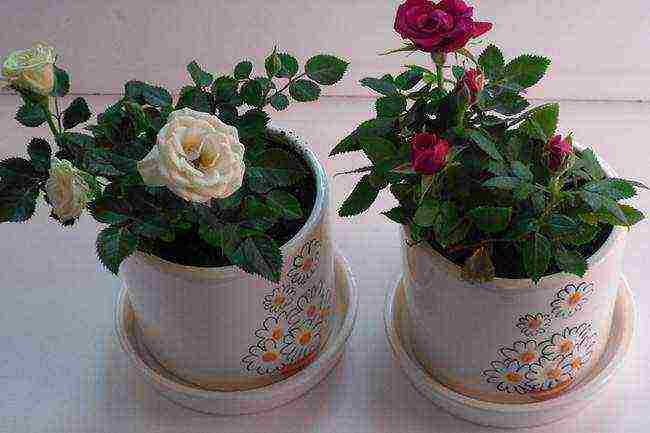
Lighting
Rose is a light-loving plant. For her well-being, she needs a lot of light. South windows are very suitable for growing. On the rest of the world, backlighting will be required in winter.
Temperature
The optimum temperature for growing indoor roses is 18-25 degrees. Since the rose is an open field plant, she loves fresh air very much and she needs it for full growth. In the summertime, the rose can be taken out into the garden or onto the balcony. The rest of the time, you need to organize airing, while avoiding drafts that are harmful to roses.
Watering
A home rose is watered with settled water at room temperature. Cold water is bad for them. The rose will be grateful for regular spraying both in the summer heat and in the winter heating season. If the rosette is near the battery, then it is better to put it in a pallet with wet expanded clay.
Fertilizers
The rosette is fed with complex fertilizers for roses from spring to winter once every 2-3 weeks, in the fall, gradually reducing the frequency of fertilizing.
Reproduction
Indoor rose is propagated by cuttings. For this, cuttings up to 15 cm long, with several buds, are suitable. They are rooted in the ground, covered with a bottle or bag on top. To do this, you can take small cups for seedlings.
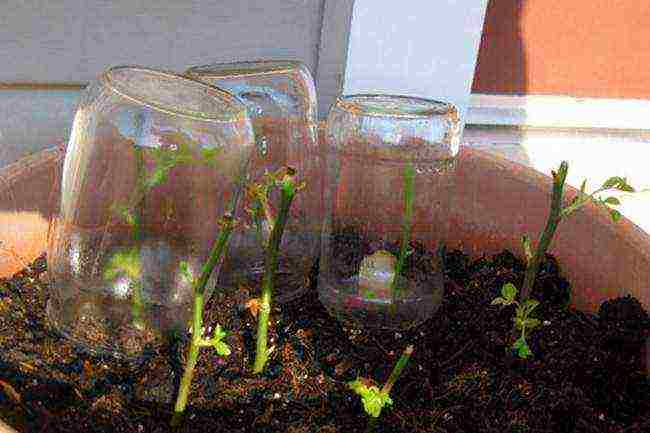
The roots appear in about 2 weeks. The greenhouse can be gradually removed after the appearance of new leaves. Transplanting rooted cuttings is possible only when the root system develops well.
Pruning
Roses periodically need pruning to form a bush. It is best produced in the spring. Branches that have lengthened over the winter, faded flowers, weak and dry branches are removed.
Diseases and pests of a room rose
Problems and solutions:
The rose dries
This problem occurs especially often in summer and winter. On hot days, the rose evaporates a lot of moisture, you need to closely monitor the moisture of the soil, not letting it dry out completely, and also spray it regularly. In winter, due to heating devices, air humidity tends to zero, the plant begins to experience a moisture deficit.
The rosette dries up in the following cases:
- the root system is damaged or dead and the rose cannot absorb moisture and nutrients
- insufficient watering and humidity
- very dry indoor air
- the rose stands near the heaters
If you notice that the leaves of your rose have begun to dry, do not wait to continue, but take measures to save the flower. First of all, you need to check the soil in the pot, if it is dry, water it. It is also recommended to remove the plant from the central heating radiators. Place the rose in a tray with damp expanded clay and spray more often. If the rosebush is small, you can cover it with a bag or bottle until the plant bounces back.
If the above measures do not help, remove the plant from the pot and see the condition of the roots. If they are dry and brittle, darkened, then the flower is threatened with death, and it remains only to take cuttings from it. Because if the roots of the plant have dried up due to rare watering, or for other reasons (sometimes they are already from the store) and died, then there is no way to restore them.
The leaves of the rose turn yellow
Why leaves can turn yellow:
- excessive watering, the roots do not have enough air
- soil poor in nutrients: there is not enough nitrogen, potassium, manganese, phosphorus
- lack of iron (chlorosis)
- putrefactive processes in the root system
- pests
If your rose turns yellow, first of all pay attention to watering, whether it is too frequent. In what form is potted soil? Does it not resemble a swamp? In this case, watering should be reduced, leave only spraying for a while.
If after the purchase you have not transplanted a rose yet, then do it urgently. The land in which they are sold is very poor in nutrients. Either the soil into which you transplanted the plant was not of the best quality, this also happens.
You can try to feed the rose with complex fertilizers for flowers, preferably especially for roses. Favorite fertilizers: Greenworld and Bona Forte for roses.
If feeding helps weakly and only for a while, then it is worth replanting the plant in a more nutritious soil. Do not transplant the rose into the ground from the garden.
If you find chlorosis in a rose - this is a characteristic yellowing of the leaves, then this indicates a lack of iron. Feed the rose with Iron Chelate or Ferrovit according to the instructions.
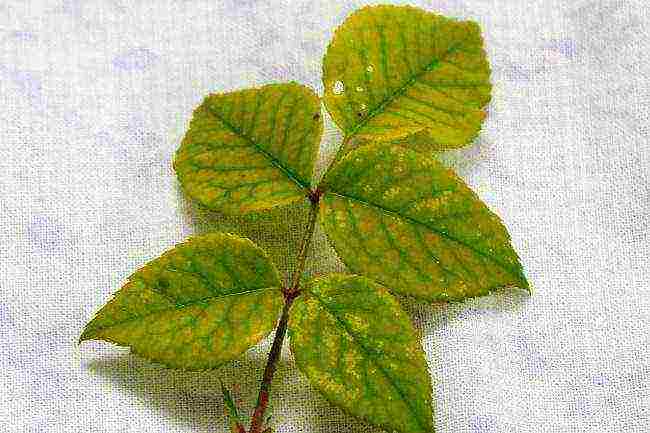 Chlorosis of a rose
Chlorosis of a rose
If the rose has been flooded for a long time (perhaps this happened even in the store + fungus often joins from high humidity), then its root system could rot. If the roots look black or brown, they are easily choked with a finger, then they are rotten and cannot be restored. If some of the roots are healthy, then the rotten roots must be removed, the flower must be transplanted into a pot with good drainage and no longer poured.
Water the rose only with water at room temperature. Strongly cold water poorly dissolves nutrients that are contained in the earth and the plant does not receive them. It also promotes decay of roots, a decrease in plant immunity and increases the susceptibility to disease.
The rose darkens, withers, leaves fall
Falling leaves may be associated with dryness (see Rose dries above). If the leaves do not dry, but wither and fall off, then this may be for the following reasons:
- the rose is frozen (draft, ventilation in winter, if the wind blew on it, etc.)
- watering with cold water
- fungal diseases
- viral diseases
- pests
Dark, limp leaves and shoots should be pruned. If the rose is frozen, then gradually it will go away by itself, dropping the frostbitten leaves.
How to recognize fungal diseases? Blackening or gray, covered with bloom, stems, all kinds of growths and plaques, spots on the leaves, "rust" of roses, powdery mildew are a sign of fungal diseases. From them we make treatment with Fitosporin according to the instructions.
How to recognize viral diseases? Changes in leaf color, mosaicism, deformation of the shape of the leaf plate are signs of a viral disease. Viral diseases are treated by removing damaged shoots and improving the conditions of the plant and increasing its immunity.
How to recognize a pest? Often, the consequences of the actions of malicious insects are visible visually. On the leaves there are either the pests themselves, they can be very small, multi-colored and transparent, but nevertheless if you look closely, you will see how they move, or traces of their vital activity - spots eaten away on the leaves, paths, black dots, cobwebs (in case of infection spider mite). In general, mites, aphids, thrips and other pests are very fond of a rose; in the summer, treatment with drugs against them is strictly required, even if you do not see them. In this case, we use Fitoverm according to the instructions.
Still, it is worth remembering that no matter how hard you try to create greenhouse conditions inside the apartment, the rose may not appreciate it, and it is best to plant it in the garden, where it will definitely feel at home.
Look at the photo of indoor roses
83,340 views
A home rose growing in a pot looks no less attractive than a garden rose. But indoor varieties require increased attention. In order for a flower from a store to grow and develop correctly at home, not to get sick, it needs to create certain conditions. All the features of the content of such a plant after purchase will be discussed in the article.
Varieties of home rose
Homemade white rose looks gentle, elegant, exudes a pleasant aroma. Before buying such a plant, you need to decide on the type. Indeed, different varieties are used for home cultivation. Photos and videos of some types will be presented below.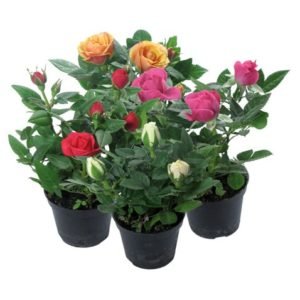
The most popular among florists are the following options for indoor varieties:
- Miniature potted species. These include the varieties GreenIce, Apricot, Stars'n'Stripes, Lavender Jewel, Mandarin, Hi-Ho.
- Repaired.
- Hybrid tea. This includes Peer Gynt, Nostalgie, Gloria Dei, Monika, Prima Ballerina, Apricot Silk, Pascali.
- Groundcover. These are Meillandecor, The Fairy, Magic and Alba varieties.
- Bengali. The most commonly grown Pink Grotendors and Ophelia.
If a florist plans to cultivate a tree and dwarf varieties of garden roses in an apartment, you should choose your own rooted bushes. After all, plants grafted onto rose hips will not grow at home.
What to do with a flower after purchase?
The shops offer a wide range of roses. Flowers for sale in containers. Often, some time after purchase, the plant begins to wither, dry out and die, and the leaves turn yellow and fall off.
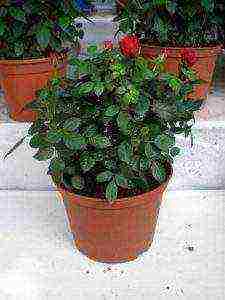 To prevent this from happening, you should perform the following actions:
To prevent this from happening, you should perform the following actions:
- Examine the flower (assess its condition, the presence of parasites). All dry and blackened branches, leaves, wilted buds must be removed.
- Carry out treatment with Fitoverm to protect against pests.
- Spray with a disease-fighting fungicide solution.
- Prune, leaving 5 buds on each shoot.
- If the soil in the pot is wet, the rose must be removed along with the lump, put on a cloth or paper. When excess moisture is absorbed into the material, plant the flower back in the pot.
- Place container in a cool, shady, draft-free area.
After that, it is important that the plant adapts to the new conditions. To do this, it is recommended not to touch it for several days. And then they start the transplant. How to properly dilute and root a flower with a handle in the country?
How to transplant a rose?
For a transplant, you will need a fertile substrate, small stones or sand, drainage material, vermiculite, a flowerpot and stimulants for adaptation.
Some experts advise rinsing the root zone, removing all soil, and then soaking it in a stimulating solution. Others argue that such a procedure is not necessary and that it is enough just to sprinkle the flower and leaves with special compounds.
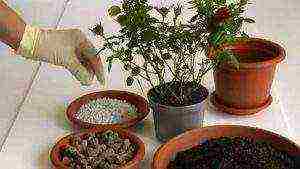 It is better to buy the substrate and soil in the store.But if this is not possible, you can prepare the soil mixture yourself. To do this, take sod, humus soil and coarse sand in a ratio of 1: 1: 0.5. To protect against diseases, it is recommended to add phytosporin in powder form to the soil.
It is better to buy the substrate and soil in the store.But if this is not possible, you can prepare the soil mixture yourself. To do this, take sod, humus soil and coarse sand in a ratio of 1: 1: 0.5. To protect against diseases, it is recommended to add phytosporin in powder form to the soil.
Drainage is placed at the bottom of the pot. Above is a layer of substrate. They put a plant and sprinkle it with earth. To create greenhouse conditions, the flower is covered with a plastic bag or jar. Under such a shelter, a home garden rose should stay for 10 days. At the same time, it is recommended to ventilate every day by removing the can or bag for a while.
The flower needs to be treated with stimulants weekly. In the future, a transplant at home is carried out every year. As the plant grows in size, it is better to choose containers 2-3 centimeters larger in diameter than previous pots.
What conditions of detention are required?
 Since the domestic Chinese rose is not a tropical plant, it needs moderate conditions. In summer, the temperature in the room should be low (from +20 to +25 degrees), and in winter you can keep it cool (+ 10-15 degrees). Overheating and low humidity have a detrimental effect on the Chinese rose.
Since the domestic Chinese rose is not a tropical plant, it needs moderate conditions. In summer, the temperature in the room should be low (from +20 to +25 degrees), and in winter you can keep it cool (+ 10-15 degrees). Overheating and low humidity have a detrimental effect on the Chinese rose.
Experts recommend placing hibiscus pots in an apartment on the western or southeastern windows. The plant is light-loving, but it must be protected from direct sunlight. In the summer, it is better to take the flowerpot with a large Chinese rose to the terrace or balcony. The soil should be used moisture and air permeable. Drainage holes should be made in the pot.
How to care for a rose?
To grow a beautiful home bush rose, you need to provide it with proper care. The plant loves good watering, periodic feeding and timely pruning. It is important to regularly inspect the flower for pests and diseases. You can read more about caring for a rose at home here.
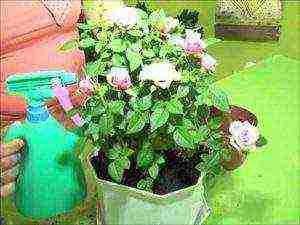 The features of home care are given below:
The features of home care are given below:
- Watering. Irrigation should be done in moderation. Frequency and abundance depend on the indoor climate. Drying and acidification of the soil must not be allowed. It is better to reduce watering in autumn and winter.
- Top dressing... Fertilized in the summer and spring seasons. The frequency is every two weeks. It is better to alternate organic and mineral mixtures. The nutrients must be dissolved in water before adding. On cold and cloudy days, feeding is prohibited.
- Pruning. The essence of the procedure is to remove dried and yellowed leaves, withered and faded buds. Pruning promotes more lush and early budding, gives the plant a well-groomed appearance. Flowers must be cut to the first leaf and bud. All weak shoots and parts are removed. In autumn, the stems are shortened to a height of 10 centimeters.
Some are trying to grow indoor bush rose by analogy with a garden rose. This is a gross mistake. After all, the home rose cordana has a number of features and at different times of the year requires certain care.
Spring flower care
 With the onset of spring, the climbing rose has new branches and leaves. From this moment, they begin to irrigate abundantly and apply mineral fertilizers to wake her up. In the evening, it is good to spray the flower with cool water from a spray bottle. If the bush has grown strongly, it is transferred to a more spacious pot. When the threat of frost has passed, the container is transferred to the balcony or garden. First, put in the shade, and two weeks later - on a sunny area.
With the onset of spring, the climbing rose has new branches and leaves. From this moment, they begin to irrigate abundantly and apply mineral fertilizers to wake her up. In the evening, it is good to spray the flower with cool water from a spray bottle. If the bush has grown strongly, it is transferred to a more spacious pot. When the threat of frost has passed, the container is transferred to the balcony or garden. First, put in the shade, and two weeks later - on a sunny area.
Summer rose care
During this period, it is necessary to organize regular watering and spraying. Nutritional formula should be added periodically. All dried parts of the plant must be removed. In hot weather, you need to monitor the condition of the park rose. It is important to notice the signs of pests and diseases in time. In order for the flower to be illuminated evenly, the pot needs to be rotated sometimes.
Autumn plant care
If at night the temperature drops to +15 degrees, the rose must be transferred from the balcony to the room and placed on the southern window sill. After the end of flowering, they begin to prepare the plant for winter. For this purpose, pruning is performed, leaving 5 buds on each shoot. Leaves do not need to be shaped or cut.
Winter flower care
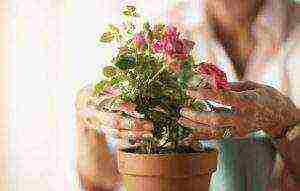 The essence of winter care is rare spraying and watering of the rose. Irrigation is carried out only three days after the substrate in the pot is completely dry. The temperature in the room should not exceed +17 degrees. Therefore, place the pot away from electrical appliances and heating equipment.
The essence of winter care is rare spraying and watering of the rose. Irrigation is carried out only three days after the substrate in the pot is completely dry. The temperature in the room should not exceed +17 degrees. Therefore, place the pot away from electrical appliances and heating equipment.
In apartments and houses with central heating, the flower should be protected against overheating. For this, the plant is placed between the frames. It is better to put the flowerpot on a stand with wet gravel or pebbles.
What are the problems with growing?
 Often, a home decorative rose is attacked by spider mites. Parasites appear when the rules of plant care are not followed. It is easy to notice the activity of pests by the appearance of characteristic dots of a yellowish tint. To fight the tick, Actellik, Fitoverm or Vermitic are used. For prevention, it is important to ensure that there is no low humidity and high temperature in the room.
Often, a home decorative rose is attacked by spider mites. Parasites appear when the rules of plant care are not followed. It is easy to notice the activity of pests by the appearance of characteristic dots of a yellowish tint. To fight the tick, Actellik, Fitoverm or Vermitic are used. For prevention, it is important to ensure that there is no low humidity and high temperature in the room.
Aphids and whiteflies also appear on the rose. To destroy such parasites, insecticidal preparations are used: Aktara or Fitoverm.
If you do not follow the watering regime, fungal infections can affect the flower. Humid, cold and stagnant air are good conditions for the development of powdery mildew. In this case, the leaves are covered with a whitish bloom, wither and fall off. To combat the disease, solutions of a fungicide, copper sulfate or colloidal sulfur are used. Another fungal disease is rust. It manifests itself in reddish-brown spots on the leaves. Infected bushes begin to develop poorly. The plant should be treated with iron vitriol, Bordeaux liquid, copper oxychloride.
Black spot is not uncommon. The fact that the flower is dying and affected by such a disease is indicated by multiple brown-black spots on the leaves. The disease usually appears with waterlogging and nutrient deficiency in the substrate. To rid the rose of spotting, the damaged areas are cut off, and the plant is treated with copper-containing agents.
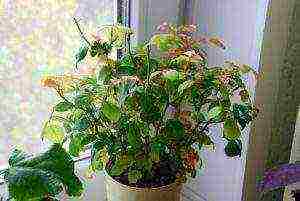 Many growers are faced with the fact that the leaves of the Bengal rose turn yellow, dry and fall off. What to do? The reasons for this condition may be:
Many growers are faced with the fact that the leaves of the Bengal rose turn yellow, dry and fall off. What to do? The reasons for this condition may be:
- Diseases.
- Pests.
- Deficiency of potassium, iron.
- Oversupply of fertilizers.
- Natural aging of the plant.
- Drafts.
- Bright lighting.
- Low humidity level.
- Improper watering.
If you carry out prevention in a timely manner, properly care for the Bourbon rose, there will be no problems.
Thus, a home rose in a pot is a decoration for an apartment. The content of the plant is simple. But in order for a flower to grow well, it needs to be properly looked after. It is important to constantly inspect for the presence of diseases, pests and, if necessary, take measures for treatment and protection.
Indoor rose. Among the variety of domestic flora, she, like her garden version, rightfully bears the name of the queen. The flower manages to maintain the leading position in popularity thanks to its unique aroma, variety of colors and the beauty of lace leaves.
Flower queens of small sizes are credited to the category of whimsical. However, such a statement is not a reason to refuse to grow a flower in an apartment. One has only to know the rules and subtleties of care, which is very different from what characterizes the agricultural technology of garden beauties.
Miniature queens enter apartments as gifts or purchases, as well as due to the passion of flower growers who strive not only to possess a beautiful plant, but also to increase the number of potted representatives on their own windowsills.
Our next material is about how to keep the purchased option, as well as start breeding the queen of flowers at home.
Rose purchased: save

Indoor rose
Everyone knows that the home rose is whimsical. Having become the owner of a flower, you need to think about preserving it.If you hold a gift pot with a magnificent, magnificently blooming specimen, it means that the flower sold in the store has received a good dose of stimulants, the effect of which, unfortunately, is very short-lived. And the packaging for gift flowers is specialized, which helps to maintain high moisture levels. Having lost intensive feeding and moisture, flowers can quickly die. In order not to have to be disappointed in the gift received or your ability to grow miniature roses, you must initially take measures to preserve the plant.
Below is a list of required actions.
- Specialized packaging, necessary to retain moisture, but contributing to the development of fungal diseases, is removed in the apartment.
- Leaves and stems (withered, blackened, withered) are cut off.
- Without regret, not only the buds are cut off, but also the bearing stem. Drastic measures will help preserve the greenhouse plant.
- If there are several plants in the gift pot, they are seated.
- The transshipment is accompanied by antifungal and pest control, for which you can use drugs such as Fitosporin, Fitoverm, etc.
Taking care of a home beauty is not limited to the listed actions. Below are the rules for keeping plants in an apartment.
Rose on the windowsill: varietal and species diversity
Tiny rose bushes are a great decoration for any windowsill. With a height of no more than 35 cm, they are in no way inferior to their garden brothers. The following plant species are distinguished: miniature, Bengal, tea-hybrid, remontant, ground cover, polyanthus and floribunda.
Rose varieties successfully grown in apartments are very numerous:
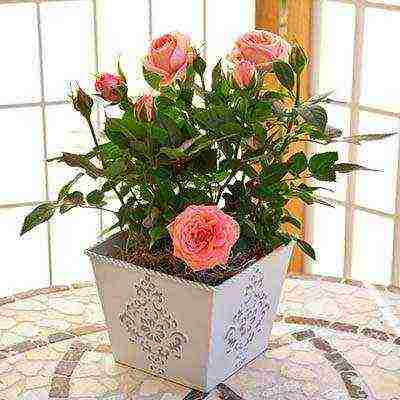
Indoor rose variety "Hi - Ho"
- Tchaikovski;
- Orange Triumph
- New Penny;
- Yellow Doll;
- Judy Fischer;
- Ophelia;
- Starina;
- Hi - Ho;
- Green Ice;
- Spice Drop, etc.
The queen of flowers is successfully grown in pots. Bengal rose (Pink Grotendors) or hybrid tea rose (Spice Drop) feel great here. And polyanthus and floribunda roses, Angel wings and Happy Child varieties, etc., feel better in tubs.
The main feature of indoor roses is their ability to multiply by cuttings without problems.
Home care for the queen
Speaking about the southern beauty, any person, first of all, means a delightful, lush blooming bush or large fragrant flowers. A rose in a pot cannot initially be large, but the duration and abundance of flowering is the result of the skill and efforts of the grower. And the components of success are the following criteria:
- the presence of sufficient free space;
- optimal humidity and acceptable temperature of the content;
- compliance with the rules for moistening an earthen coma;
- timely processing of the soil and the plant itself;
- prevention of diseases and the spread of pests.
Correctly organized wintering of a flower will allow you to admire the bright greenery and numerous buds in early spring.
Before thinking about wintering, remember that traditionally, miniature specimens of a flower brought from foreign greenhouses are placed on the shelves of flower shops. For cultivation for sale and long-term preservation of the presentation, flowers are fed with growth and flowering stimulants, which negatively affects the life expectancy of asthenia outside greenhouse conditions.
Having acquired such a copy, you should take care of its preservation in the changed conditions. To do this, as noted above, the plant must be transplanted into a large container with fresh soil and all the buds must be removed, and not only the inflorescences are removed, but also part of the stem. New shoots that have appeared at the pruning site are also pinched. And only after this is the possibility of flowering a home beauty allowed.
To preserve the compact volumes of the rose bush in the period preceding the onset of active bud growth, that is, at the beginning of spring, formative pruning is carried out.
Reproduction
To increase the number of a miniature version of the queen of flowers, a vegetative method of reproduction is used. The main material is the branches left after pruning. Their length should not exceed 15 cm, no more than 4 buds are left on the stem.
In order for the cuttings to take root, they are placed in water with a dissolved activated carbon tablet or a mixture of sand and peat. Another option that can help the cuttings take root is processing the branches with Kornevin or infusion of willow branches. It is worth waiting for the appearance of roots no earlier than 14-20 days, after which the seedlings are planted in separate containers.
If a sandy-peat substrate was used to root the branches, then the cuttings must be placed in an impromptu greenhouse. The development of the root system is evidenced by the beginning of the appearance of new foliage. The period of adaptation of the seedling to indoor conditions should be gradual.
Video "Propagation of a room rose by cuttings"
Transfer
Repotting is recommended in early spring. The second allowed period is the end of August.
The purchased plant must undergo adaptation to the new conditions before being transplanted into a new container that is larger than the shipping pot and is approximately 5 and 3 cm in height and diameter, respectively. How to transplant a flower without damaging it? The previously moistened soil will help to remove the plant from the pot.
In a new container, it is necessary to lay a drainage layer, which is covered on top with a small amount of fresh earthen mixture. A plant moved with an earthen clod should stand tightly in the pot, which is ensured by a uniform volume of soil poured along the edges of the new container. The transplanted flower must be placed in partial shade for several days, and then moved to the place designated for it. Moisturization should be moderate, at the root. Spraying is encouraged.
Top dressing begins no earlier than a month after the plant has been transplanted. Mineral fertilizers are recommended, the solution of which is used twice a month for root and foliar feeding.
Video "Transplanting indoor roses"
The right growing conditions
Despite the well-established opinion about the capriciousness of a miniature beauty, even beginners can refuse questions about how to care for a rose, provided that the initial organization of acceptable conditions for keeping the flower. The focus is on the following parameters:
| Light mode. | There should be a lot of light. However, constant exposure to direct sunlight leads to rapid opening of inflorescences and bud fall. To ensure sufficient lighting in winter and in apartments with insufficient access to sunlight, it is recommended to install special phytolamps, the spectrum of which covers the red and blue range. |
| Air humidity. | Low moisture readings are the main enemy of lush flowering and flower life. In hot summer weather and in the stuffy atmosphere of apartments during the heating season, it is advisable to provide constant, abundant spraying (twice a day) and access to fresh air. Constant humidity can be ensured by placing the flowerpot in a pallet with damp expanded clay. |
| Watering. | During the summer, it should be abundant. At the end of summer, you should think about where to put a rose in an apartment for the autumn-winter period (in winter, cool rooms or places away from batteries are chosen) and take care of reducing the amount of moisture in the earthy coma. Remove excess water from the pan. Waterlogging or overdrying of the earth leads to the death of the flower. The water should be kept warm. |
| Temperature conditions. | An indoor flower should be protected from overheating, leading to the development of various diseases. |
| Top dressing. | The process is carried out after moistening the earth twice a month with organic and mineral fertilizers specially developed for the queen of flowers. An alternation of dressings is required. During the dormant period, fertilizers are excluded. |
| Pruning. | The question of how to cut a rose correctly is not difficult. Events are organized in the fall. The flower shoots are shortened so that only 5 buds remain. Weak and thin branches are subject to removal. |
| Peace. | This period begins from the moment the last flower falls and lasts until February. For a good "rest", a temperature within the range of 4-6ºC is required (the maximum permissible temperature is 10-14ºC). At the end of winter, the temperature of the content is increased to 15-18ºC. |

How to properly prune a rose after flowering
Difficulties of growing
The main difficulties in growing a flower are its susceptibility to disease and damage to various pests.
Indoor rose pests:
- spider mite;
- whitefly;
- aphid.
Methods of dealing with them should be systematic. Effective drugs to prevent the reproduction of pests - Actellik, Akarin, Strela, Aktara, etc. Along with non-toxic products, regular spraying with warm water is used. Warm showers are welcome.
Diseases of a room rose can develop due to an incorrectly selected irrigation regime. Their treatment involves the treatment of bushes with effective mixtures and pruning of affected branches. There are such diseases:
| Diseases | How to treat |
| powdery mildew | fungicide, copper sulfate and cumulus |
| rust | oxychloride and copper sulfate, Bordeaux mixture |
| black spot | copper-containing preparations |
Disease prevention - compliance with temperature and irrigation regime. Adhering to the above conditions, you can provide a miniature beauty with a long period of life and an abundance of flowering.
Video "Why indoor roses dry"


